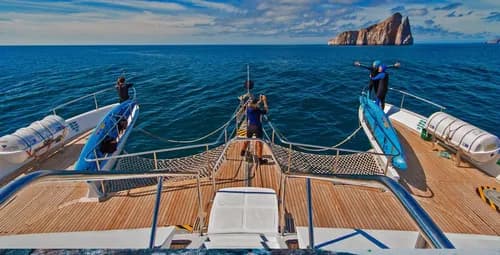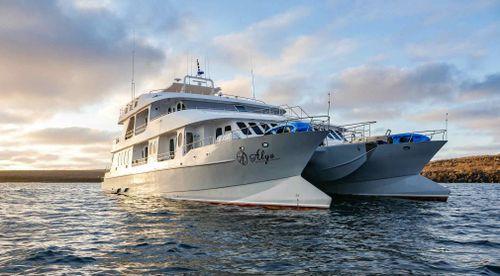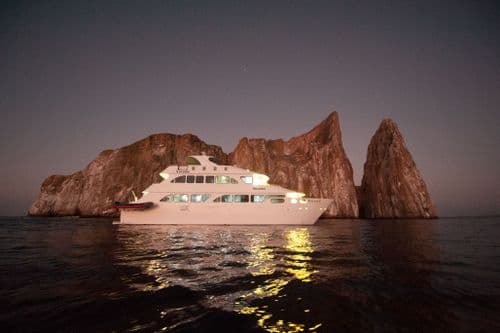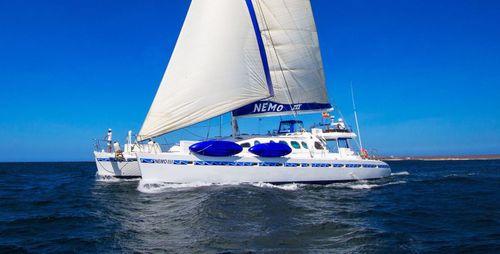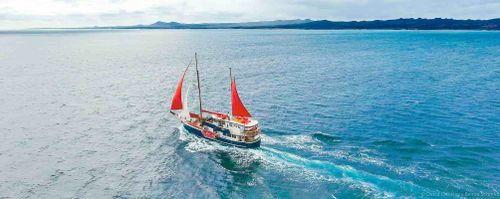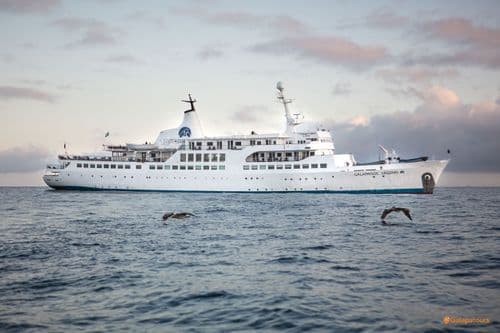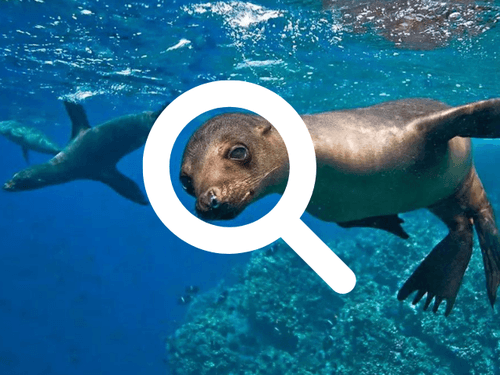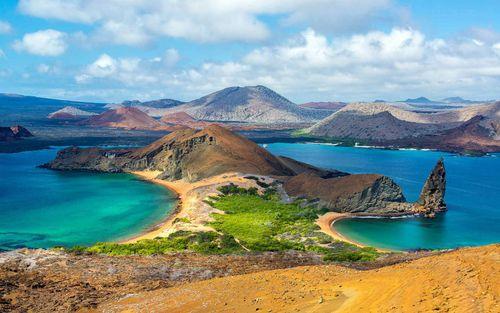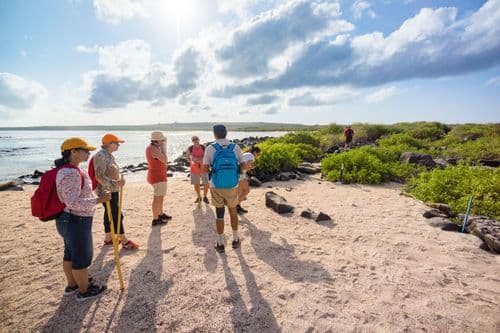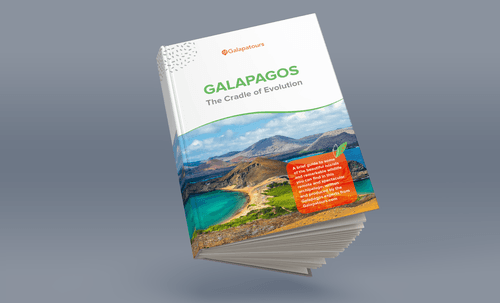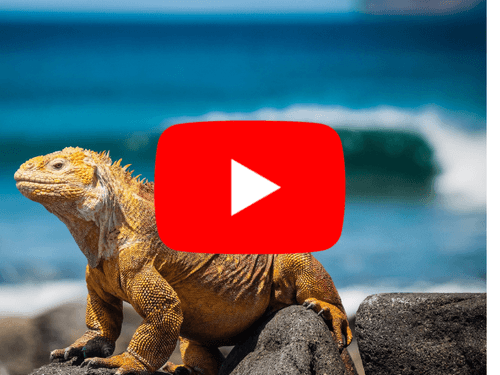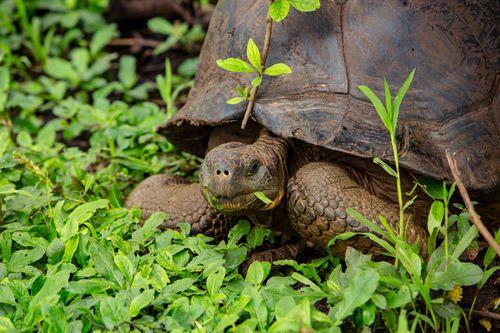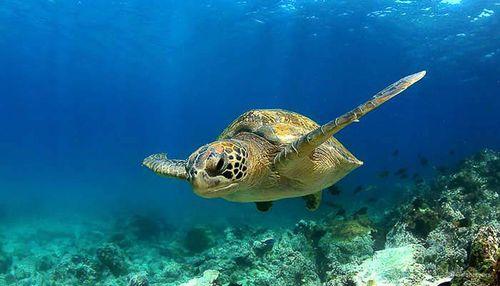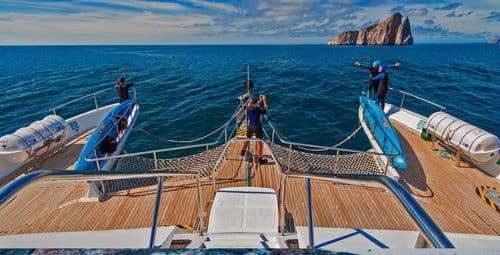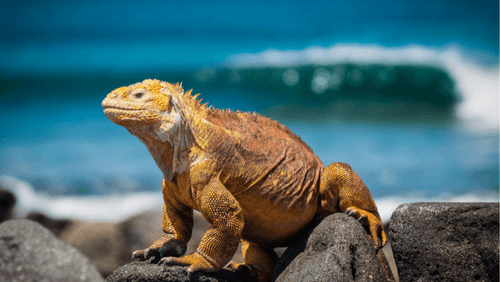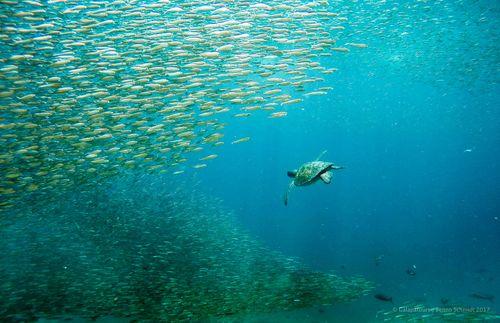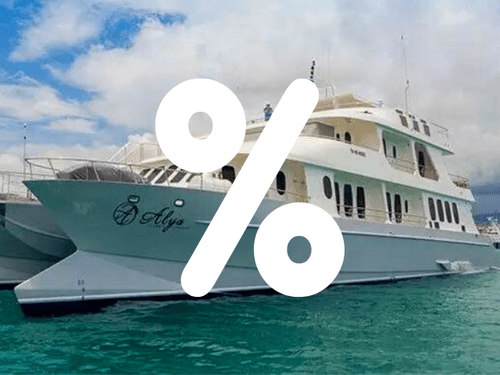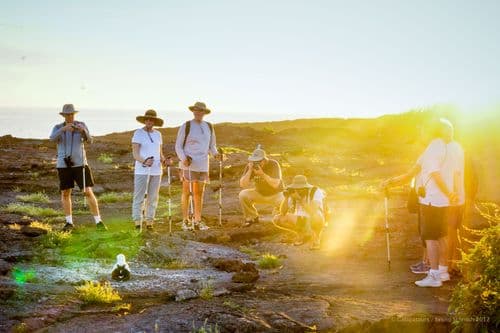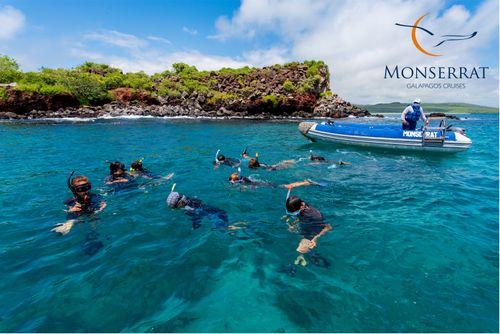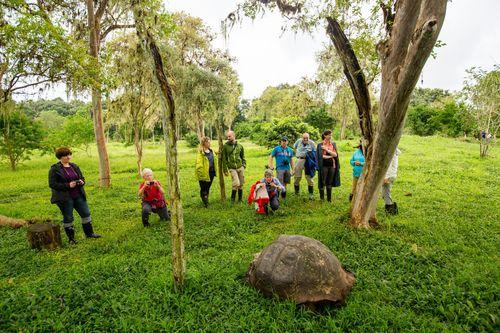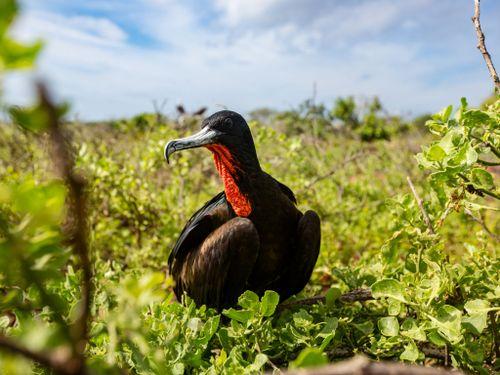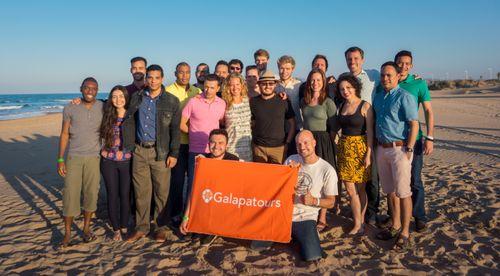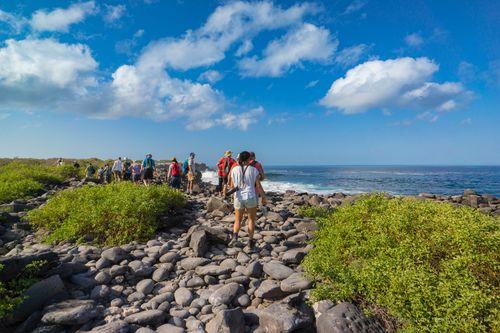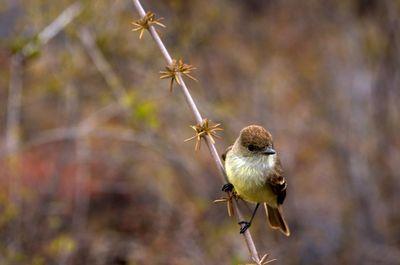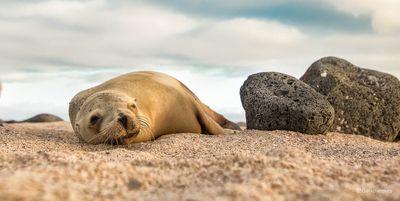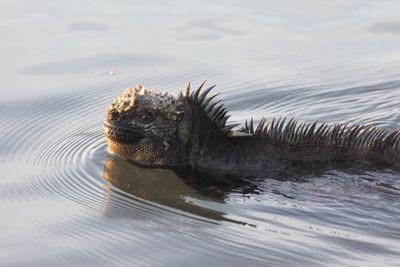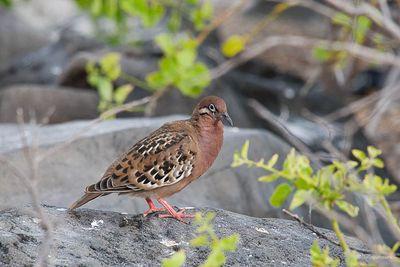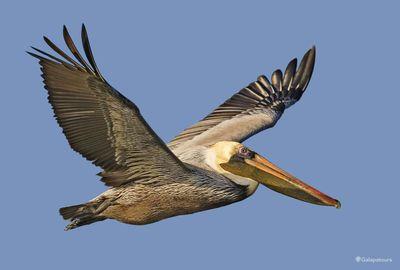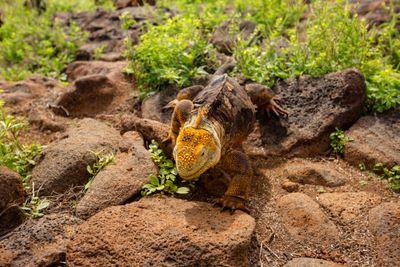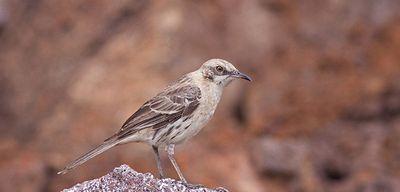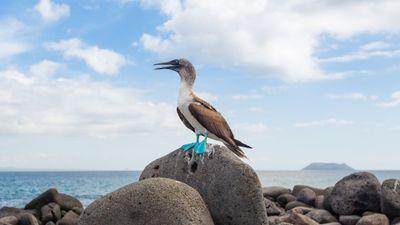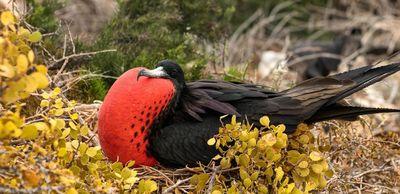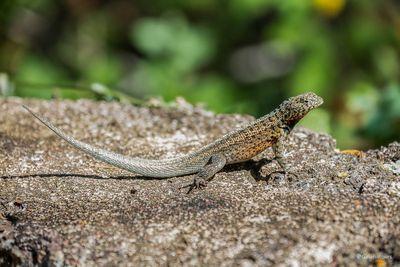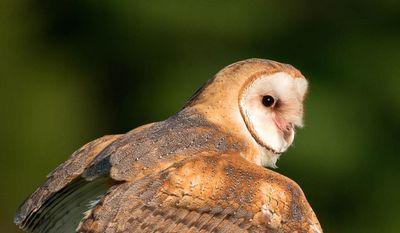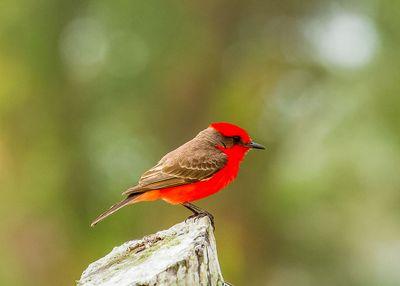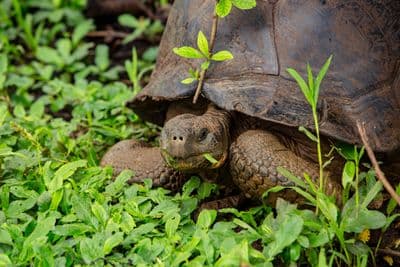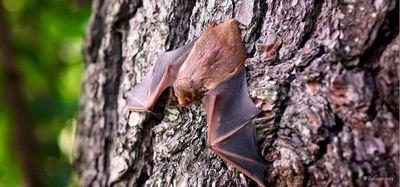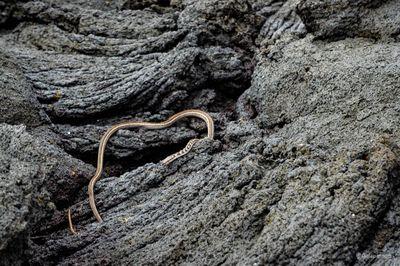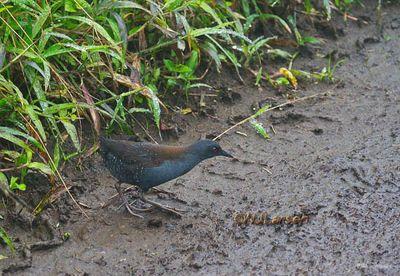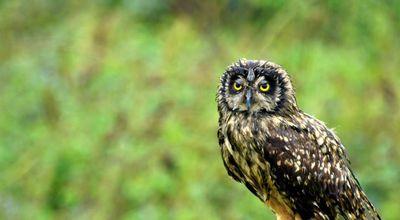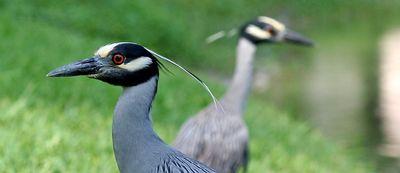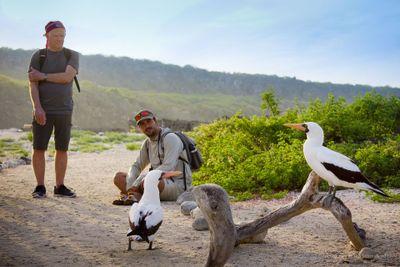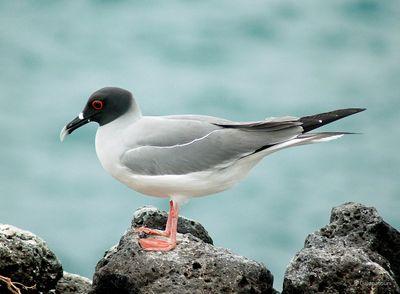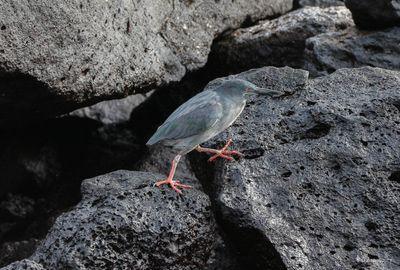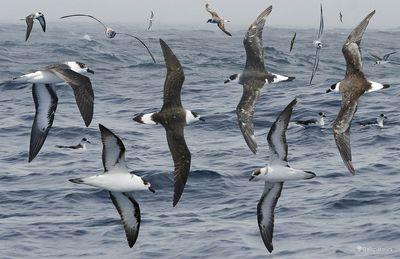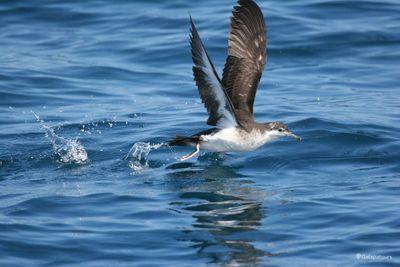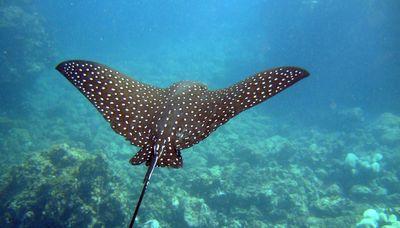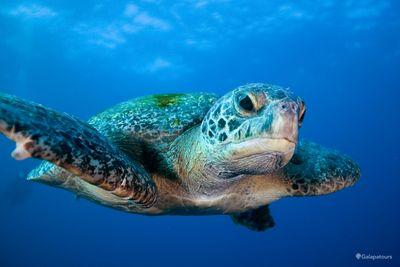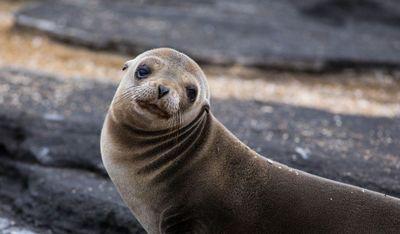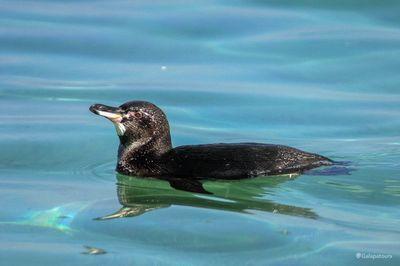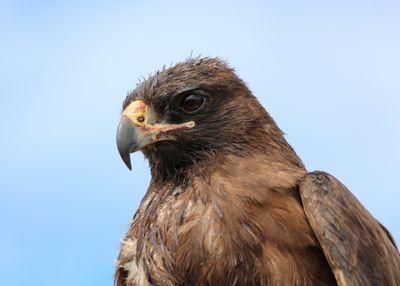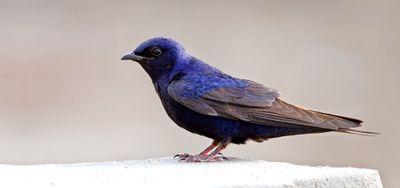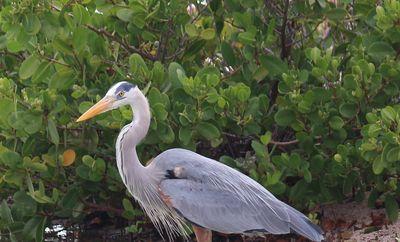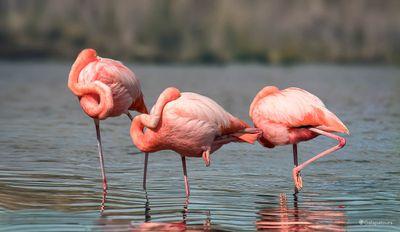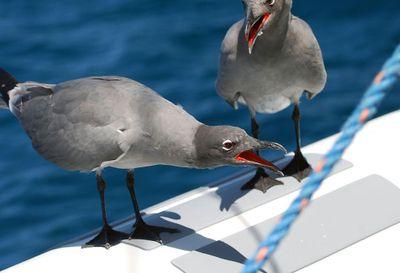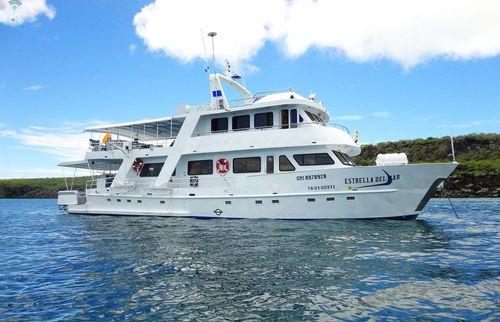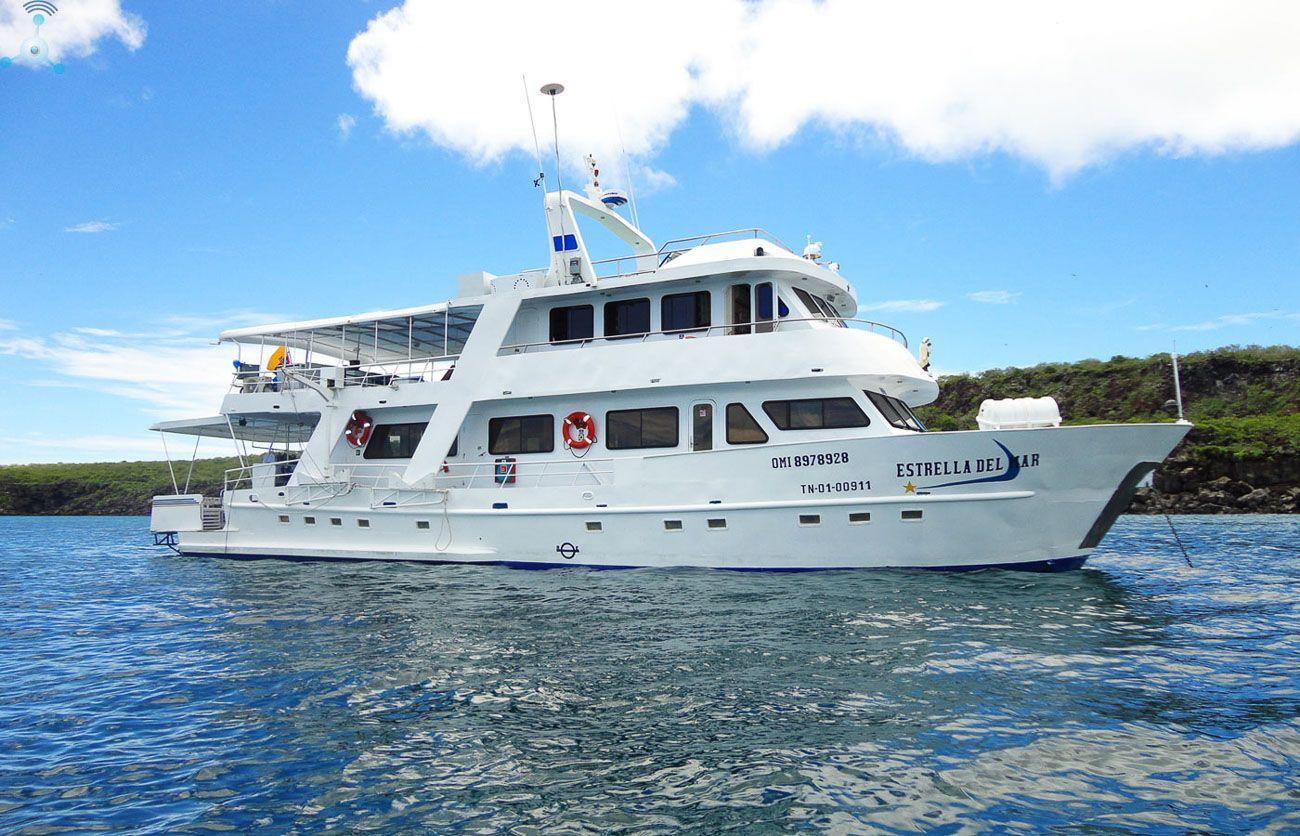
West, Central & East Galápagos
8 Days Galápagos cruise on board the Estrella del Mar
Length
8 Days
Ship category
Classic
Ship type
Small Yacht
Capacity
16 Passengers
West, Central & East Galápagos
7 Reviews
Trip highlights
Thousands of Marine Iguanas at Espinosa Point
Scientific insights at C. Darwin Research Station
Green Turtles nesting at Espumilla Beach
Mars-like landscapes at Rábida
The Galapatours experience
Super comfortable cabins
Great value option
English-speaking guide for all activities
Lectures in the evening
Get to know the highlights of Galápagos with this Naturalist cruise on board the beautiful Estrella del Mar! On this Expedition Cruise, you will discover the incredible wildlife of the Galápagos Islands: Fernandina, the youngest island, will blow your mind with its rugged lava landscapes. The youngest island in the archipelago, it is still being formed by volcanic eruptions and makes for a wonderful, otherworldly contrast to the other islands. Isabela, the biggest of all islands in the Galápagos, offers you fantastic hikes, views and arguably some of the best snorkeling spots in the Archipelago. During your time spent on Rábida, you will have the opportunity to watch wild Flamingos and walk on a blood-red sandy beach. On San Cristóbal, you will be able to snorkel in crystal clear waters, relax with sea lions on pristine white sand beaches and learn more about the evolution of giant tortoises. During your time on Santa Cruz, you will have the chance to observe the famous Galápagos Giant Tortoises in the wild and learn more about the preservation and scientific study of these amazing animals. On Santiago, an island formerly inhabited by pirates, you will be able to enjoy hikes and dinghy rides.
Your ship: Estrella del Mar
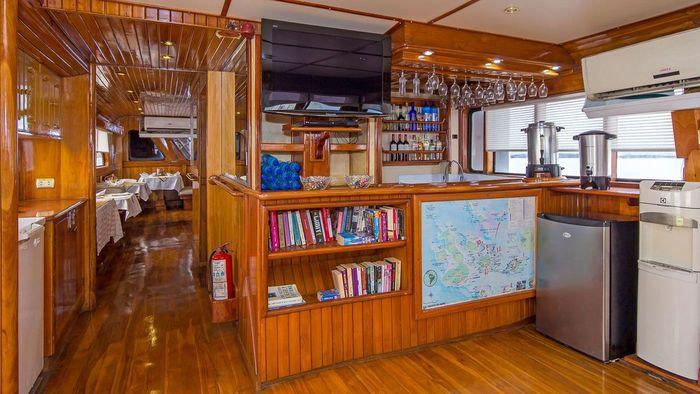
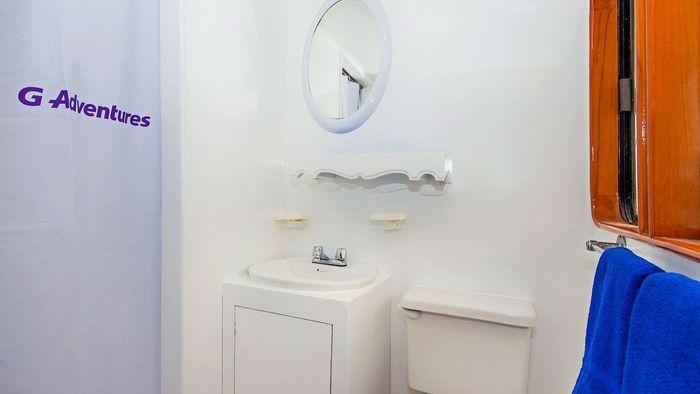
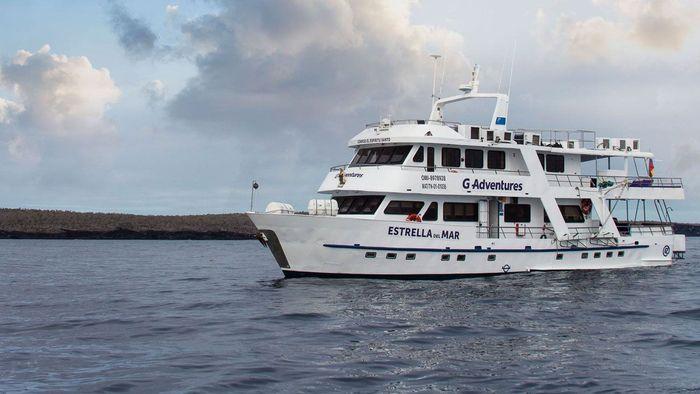
- Great value option;
- Comfortable accommodation;
- Great reviews for the chef;
- Wide range of itineraries.
Estrella Del Mar offers an excellent option for those who want to cruise the Galápagos in comfort, but are prepared to sacrifice some top end luxury for excellent value. Built in 1990, Estrella uses her space cleverly, so that she never feels crowded. Limited to a maximum of 16 guests, you’ll have a great experience as you cruise between stunning sites of interest around the Galápagos.
Comfortable Cabins Estrella Del Mar has eight cabins, four on the lower deck, and four on t … Read more about Estrella del Mar
Cabins
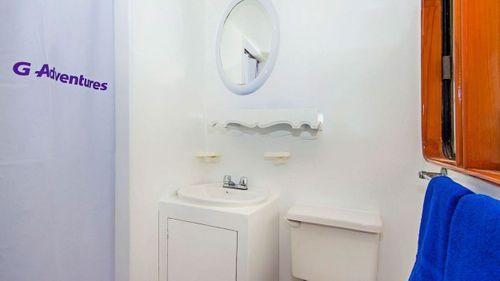
Amenities
Transfers to and from ship
Snorkel gear (free of charge)
Travel for good: Your Each booking contributes to Ventura’s Conservation Project.
All meals
Air conditioning & private bathroom
Single travellers can share cabin
Water, Coffee, Tea & fresh juices
Wetsuits
English guide
Flights to and from Galapagos
Food & Drinks
The food on our Galapágos Cruises is among the very best you will find in South America. Most of the on-board chefs are internationally trained and have prior experience working in the best hotels and restaurants in Ecuador and indeed around the world.
You can expect a first-class selection of food, including a good variety of fresh fruits and vegetables, locally sourced poultry and fish/seafood, rice and pasta dishes. Most boats will always include some typical Ecuadorian dishes on the menu during your cruise. If you have specific dietary requirements then these can usually be accommodated by the chef providing you have given advance notice. Please make sure you tell us about any allergies or dietary requirements you have at the time you book with us. If you leave it until you arrive at the dockside, then it may well be impossible to accommodate your needs.
Most boats serve a range of options at meal times in a relaxed buffet-style. At the first class and luxury end of the market, some boats have more formal dining where you will be served at your seat. However the atmosphere is always relaxed on board our cruises, and never stuffy or formal.
Map
Itinerary
Your itinerary below may vary, depending on the weather, wildlife breeding, and local conditions.
Pre-trip add-ons

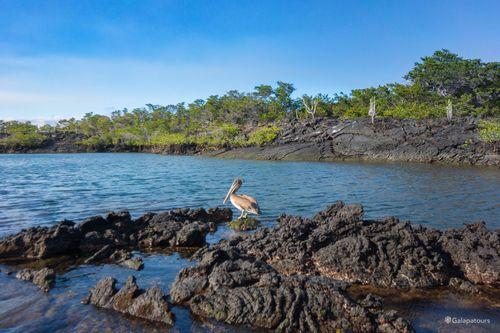
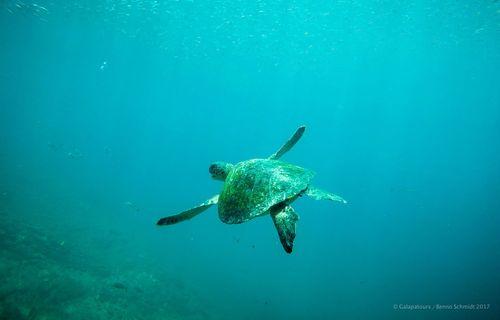
Day 1
AM
Arrival at Baltra airport+transfer to ship
Baltra • Arrival at Baltra airport+transfer to ship
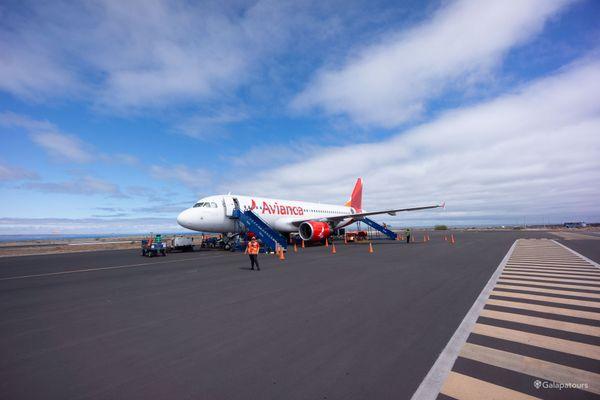
Welcome to Galápagos! Once your flight has landed and you went through the immigration process, you'll be met in the Arrivals lounge by our English-speaking guide who will take you to your transfer vehicle for the short journey to your waiting ship.
Baltra Island, where your arrival airport is, was used as an important Air Force base in the Second World War. This is the primary airport for the Galápagos Islands and you'll be rubbing shoulders with fellow tourists, international naturalists and conservationists, researchers and academics, and Galápagos residents alike. The airport has been built as a "green" airport, and as well as using recycled materials in its construction, it's special design keeps the buildings relatively cool without the need for any air conditioning.
Once on board your ship, you will be introduced to the crew and given a welcome briefing as well as an important safety drill. After this you'll be shown to your cabin. While you're served a well-deserved and delicious lunch, the captain will cast off and your adventure truly starts.
Note: If you plan to spend a few days prior to the cruise in Puerto Ayora and want to do the cruise later this is no problem at all. The transfer from Puerto Ayora to Baltra is very easy.
Day 1
PM
Santa Cruz Highlands
Santa Cruz • Santa Cruz Highlands
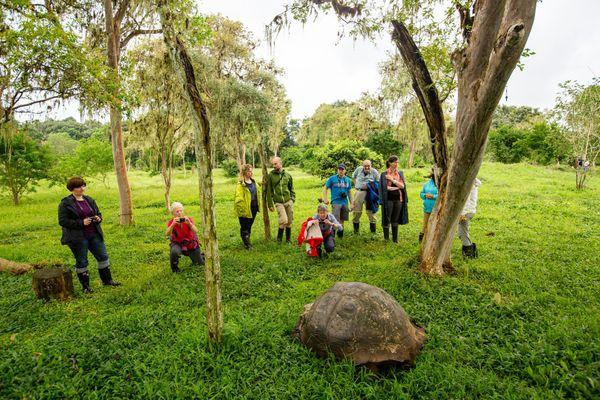
Santa Cruz is the only island on the Galápagos that allows you to travel through every habitat type that exists in the archipelago. This makes the journey north from the coast up into the highlands a fantastic opportunity to experience the breadth of life that exists on these islands.
Your bus journey starts from Puerto Ayora on the coast and you slowly start to climb through the agricultural zone where open fields begin to give way to lush, green, mist-covered forests. This is a marked contrast to many of the islands which are at much lower elevation and much more arid. This rich verdant landscape is predominantly made up of dense Scalesia forest.
Your expert Galapatours guide will stop several times along the route to allow you to explore various different sites. Among the stops will be a Giant Tortoise reserve, and also a visit to the famous lava tubes. Over half a mile long, a walk through these natural volcanic features is eerie and unforgettable.
Also along the way you will stop for refreshments, and you'll be able to try locally-grown Galápagos coffee - we think it's among the best we've ever tasted!
Day 2
AM
Chinese Hat
Santiago • Chinese Hat
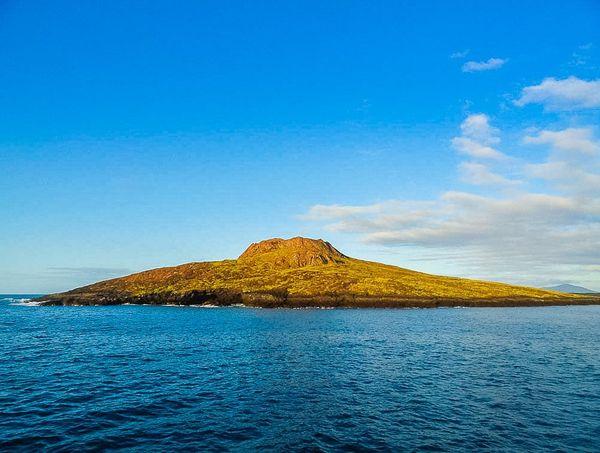
Chinese Hat ("Sombrero Chino" to locals) is an islet set just a short distance off the southeastern coast of Santiago. The small channel between Chinese Hat and mainland Santiago is fairly deep yet sheltered, and the water here is a glistening turquoise.
The islet gets its name because if you approach from the north, you will see that this small volcanic cone does indeed look like the traditional bamboo or rice hat. Viewed from above on a satellite image, however, you will see that this islet is actually more of an oval shape.
There is a short hiking trail on Chinese Hat that runs along the western coast of the islet. This is a harsh landscape of volcanic rubble and lava formations, a very atmospheric reminder of the fiery origins of the Galápagos.
Along the cost of both Chinese Hat and the opposite Santiago shore you are likely to see Galápagos Sea Lions and Galápagos Penguins, either basking in the sun or seeking shade to avoid the hottest parts of the day. Overhead, you might catch a glimpse of the magnificent Galápagos Hawk.
The stand-out reason for a visit to Chinese Hat however is to snorkel in that turquoise channel. Here you can see various species of sharks, rays, and a variety of tropical fish. Not all Galápagos boats can visit, and permits are only given to a select few boats and guides. Here at Galapatours we offer itineraries on all of these specially selected boats, so if a visit to Chinese Hat is important to you, speak to one of our Galápagos experts today to help choose the perfect itinerary.
Day 2
PM
A walk on Rabida Island
Rábida • A walk on Rabida Island
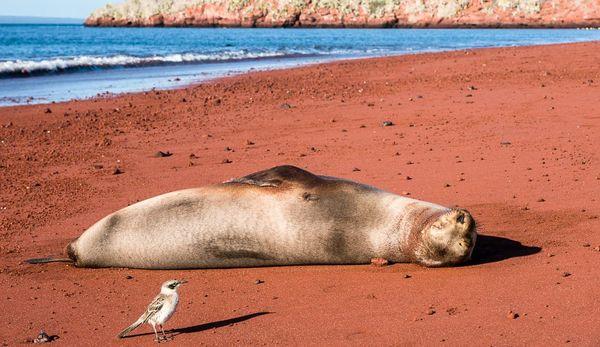
Rabida is a small, steeply-sloped island with red-sand shores, and was originally called Jervis. Despite its small size, Rabida has one of the highest concentrations of volcanic features in the Galápagos, and it's thanks to the iron-rich lava deposits that its sands and soils are so red.
After a wet landing on the northern coast you will often see Galápagos Sea Lions and marine iguanas around the beach, especially near the sheltered caves in hot weather. Just behind the beach is a nesting site for brown pelicans, who use the saltbush as cover. Rabida is one of the best spots in the archipelago to observe pelicans. Sometimes flamingos can also be seen in the lagoon here.
There is a short hiking trail that leads further inland through Opuntias where there are good opportunities to see land birds like Darwin's finches, Galápagos Doves and Galápagos Mockingbirds.
After your trip inland you can then have a relaxing swim and enjoy some snorkeling, which is very good in the clear waters off the beach. While you swim, you'll be able to see Blue-Footed Boobies taking off over your head from their cliff-top roosts.
Day 3
AM
Espumilla Beach
Santiago • Espumilla Beach
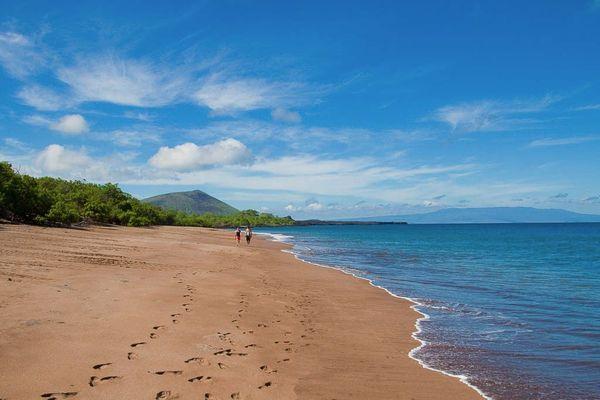
Espumilla Beach is located at the northern end of James Bay, a large bay on the northwestern coast of Santiago. This is a pretty beach that is fringed with lush green forests.
The beach itself is home to marine iguanas who feed among the rocks at either end of the beach, and it is a good place to snorkel, with visitors often reporting sightings of sharks, rays and octopus. This is also a nesting site for Galápagos green turtles.
There is an inland hiking trail here that takes visitors past a seasonal lagoon that's often bright green thanks to the algae in the water. Here you can find Galápagos flamingos and pin-tail ducks. The trail then loops through the arid zone, where you can see further bird species including Galápagos Hawks that often circle overhead.
Day 3
PM
Egas Port
Santiago • Egas Port
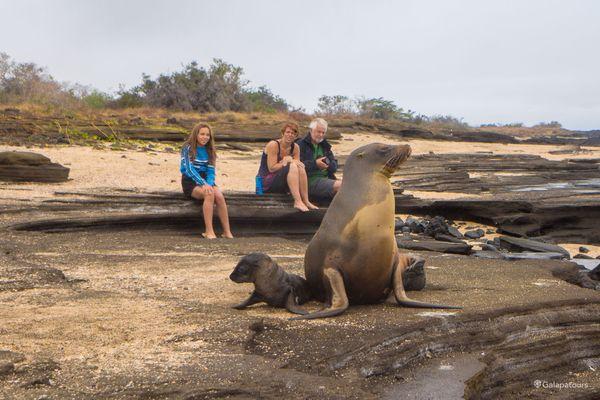
Puerto Egas (Port Egas) is a sheltered landing site at the southern end of James Bay on the northwestern coast of Santiago. This landing site is the trailhead for two hiking paths.
The first trail runs along the coast to visit the so-called "Fur Seal Grottos". The Galápagos Fur Seals like to seek shade from the equatorial sun, and they prefer rocky shores with caves or other nooks and crannies in which they can keep cool. The grottos here are perfect for them, and the tidal pools are also popular with Galápagos Marine Iguanas who can be seen feeding in and around them.
The second trail from Egas Port heads inland to the "Salt Mine Volcano". This hike is just under 2 miles long and takes you to the rim of a salt mine crater. This "mine" is actually a small volcanic cone that is filled with a salt water lagoon that dries up in the dry season. At several points in the 20th century individuals or companies attempted to mine salt from it, but without commercial success. The name of your landing site is after the owner of the last company to try salt mining here, Hector Egas.
The lagoon is often home to Galápagos flamingos and other birds, and the wonderful Galápagos Hawk can often be seen circling above this area.
Day 4
AM
Espinosa Point
Fernandina • Espinosa Point
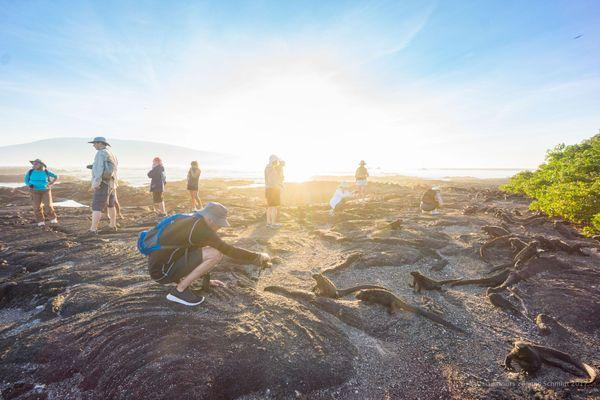
Fernandina Island has never been colonised by any non-native species, and this makes it ones of the world's most pristine island ecosystems. Coupled with its young age (Fernandina was only formed a few hundred thousand years ago) this makes a visit to this Galápagos island very special indeed.
At Espinosa Point on the northeastern shore of Fernandina the vista is dominated by "La Cumbre", the volcano whose lava fields formed the island. A visit to Espinosa Point is high on many people's list thanks to the number of iconic unique Galápagos species you will see here. As well as the noisy and fun-loving Galápagos Sea Lions, Espinosa Point is a great place to see Marine Iguanas, the wonderful Galápagos Penguins and the unique and endangered Galápagos Flightless Cormorant. If you are very lucky and keep your eyes skyward you may also catch sight of a Galápagos Hawk circling overhead looking for its next meal.
Day 4
PM
Urbina Bay
Isabela • Urbina Bay
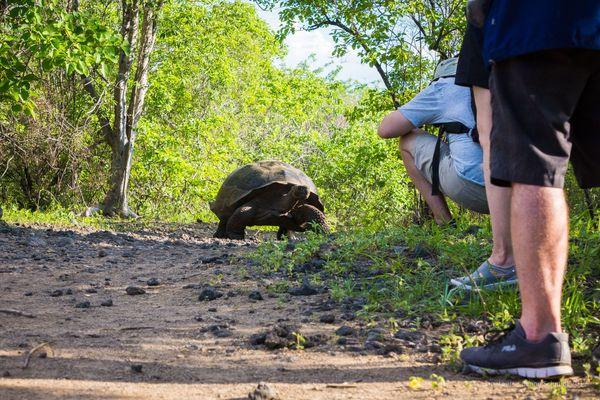
Urbina Bay is one of the youngest features in the Galápagos. It was mainly formed in 1954, when a sudden uplift of the land raised the seabed by over 5 metres, and pushed the coastline over 1 km further away. This has resulted in the astonishing site of heads of coral stranded far from the water. Exposed to the air and elements, the coral heads are rapidly deteriorating and are one of the sights of the Galápagos that won't be around for much longer.
Once ashore, a long hiking trail will take you away from the beach and into the island's arid zone. In this habitat, you are likely to see wild Galápagos Giant Tortoises and Galápagos Land Iguanas. As the trail circles back towards the shore line you'll come across colonies of the unique Galápagos Flightless Cormorant.
This is a pleasant area for snorkeling, and as you enter and leave the water you might do so watched by some Galápagos Penguins, who have a colony nearby. This is also one of the best sites to see Galápagos Marine Iguanas feeding underwater.
Day 5
AM
Elizabeth Bay
Isabela • Elizabeth Bay

On the eastern coast of Isabela, the wide and sheltered Elizabeth Bay is a haven for wildlife. With areas of mangrove on the shore that contrast with the surrounding lava fields, and a myriad of small islets and rocky reefs, this is a particularly rich area for wildlife.
Accessible only by panga (small motorised dinghy), exploring Elizabeth Bay will provide you with an opportunity to get up close and personal with many of Isabela's species. During your 2 hour boat ride around Elizabeth Bay you can see rays, sharks, green sea turtles, Galápagos penguins, pelicans, and plenty of Galápagos Sea Lions. Nearer to the shores and mangroves, you'll see Galápagos Flightless Cormorants and marine iguanas.
Galapatours guests regularly tell us that Elizabeth Bay is one of their favourite Galápagos excursions and visitor sites.
Day 5
PM
Moreno Point
Isabela • Moreno Point
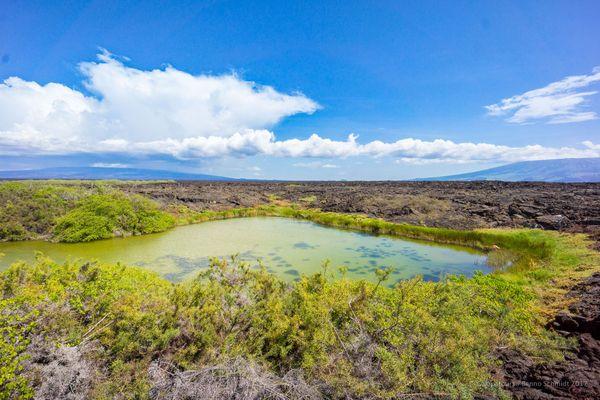
Moreno Point (known locally as Punta Moreno) is a short journey from Elizabeth Bay on the west coast of Isabela Island. You will take a panga ride which will give you great views of the striking rocky shoreline before you make your landing.
Here you will see the eerie site of a huge lava field leading up to the distant Cero Azul volcano. Hiking through this alien landscape you will come across several tidal lagoons, pools and mangroves - all of which provide an oasis for a range of wildlife, particularly bird species. In the larger tidal pools you may see green turtles or sharks, the clear waters giving you a unique opportunity to view them from on land!
On your journey back to the boats from your 1.2 mile hike you're likely to see Galápagos Penguins on the rocky shores as well a range of birds including herons and Galápagos Flamingos. This is a favorite excursion as it combines the opportunity to see coastal species with a hike through stunning landscapes.
Day 6
AM
Las Tintoreras
Isabela • Las Tintoreras
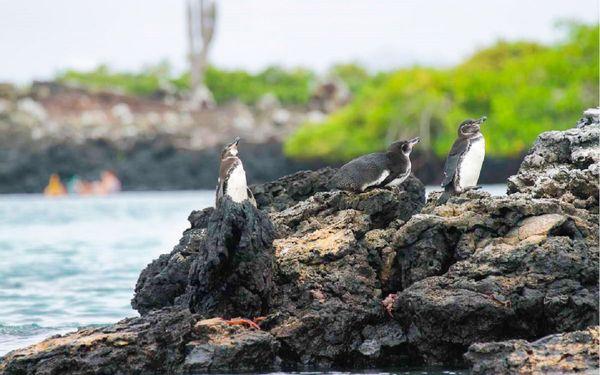
Las Tintoreras are a group of small islets just a few hundred metres from the shores at Villamil, only accessible by kayak or panga. The network of Tintoreras forms a patchwork over the stunning turquoise waters of the bay, and this natural shelter is a haven for wildlife.
At low tides, one shallow lagoon is famous for offering amazing views of sharks swimming near the surface - the water clarity is such that they often look like they are floating in air! Other species that call Las Tintoreras home include Galápagos marine iguanas and friendly (and noisy) Galápagos Sea Lions.
Depending on tide conditions and time of year, it may be possible to snorkel here. If this is important to you, speak to one of our Galápagos experts who can advise you on the best itineraries to choose to meet your requirements.
Day 6
PM
Sierra Negra Volcano & Arnaldo Tupiza Tortoise Breeding Center
Isabela • Sierra Negra Volcano

Sierra Negra is renowned as the most impressive volcano in the Galápagos. The crater is over 6 miles across and is the second largest in the world.
However, to visit the volcano is quite a logistical effort. The only way to get there is to start with a 45 minute drive from Villamil to a trailhead from where you can follow another 2 hours of trails up to and along part of the rim.
There's also the option to walk on quite recent lava flows, as the so-called parasitic cone of Volcan Chico last erupted in 1979 leaving large flows to cool to rock.
The journey is well worth the effort, as the views from the rim of Sierra Negra are simply stunning. You can see across the other volcanoes on Isabela and across to Fernandina.
Your expert Galapatours guide will explain in detail about the geological processes that shaped not only this part of Isabela, but of the whole Galápagos.
Isabela • Arnaldo Tupiza Tortoise Breeding Center
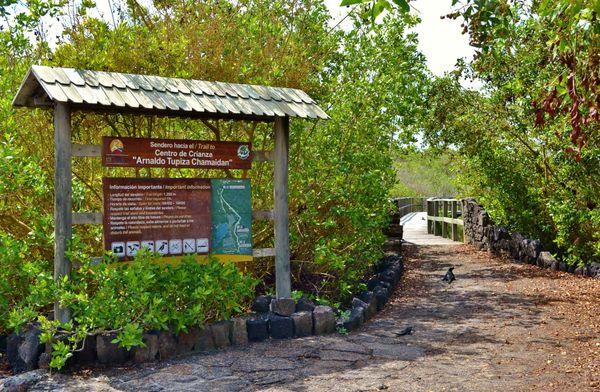
A short walk from Puerto Villamil on Isabela Island will bring you to the Arnaldo Tupiza Tortoise Breeding Center. The short trail from town is lovely in itself - you follow a boardwalk that takes you across the wetlands and Opuntia cactus fields.
At the breeding centre you can see 5 different subspecies of Galápagos Giant Tortoise that are all native to Isabela, but currently threatened by habitat damage caused by introduced animals and volcanic eruptions. Here, the Giant Tortoise eggs are carefully incubated in a special hatchery, whilst the adults are cared for in large supervised corrals. This careful breeding program is aiming to increase the populations of these remarkable animals to ensure their survival as a wild species that's unique to the Galápagos.
Day 7
AM
Charles Darwin Research Station
Santa Cruz • Charles Darwin Research Station
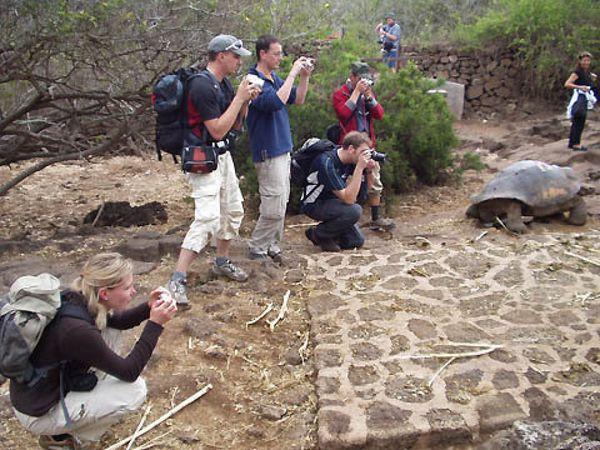
The world famous Charles Darwin Research Center is just a 10 minute walk from downtown Puerto Ayora, and is the home of the non-profit Charles Darwin Foundation.
Inside, you'll find exhibits about the geography, geology and climate of the Galápagos, and the evolution of her unique species. There is also lots of information on the Foundation's current conservation and education programs.
As well as conducting it's own key research, the Charles Darwin Center also hosts international scientists, and supports the work of government agencies like the Galápagos National Park.
Next door is the site of the Galápagos' first giant tortoise breeding center, where pioneering work has been done since 1965 for the preservation of these species. Here you can see newly hatched babies, up to juveniles and full-grown adults ready to be released back into the wild.
Day 7
PM
Tortuga Bay Beach
Santa Cruz • Tortuga Bay Beach

Tortuga Bay Beach is a delightful 1 mile walk from Puerto Ayora and is one of the prettiest beaches on the Galápagos.
As you walk the trail to the beach you cross through an area of arid vegetation which is filled with bird life, and your Galapatours expert naturalist guide will help you to identify many species here, which include the famous Darwin's Finches.
Once you reach the beach you will see a glorious tropical scene - white coral sands and breaking turquoise waves. You can often see surfers here, and they are a clue that those waves hide strong currents and tides, and you need to be careful if you choose to swim. A better option might be to continue along to the second part of Tortuga Bay Beach which is the other side of the headland. This beach opens onto a small bay that's almost completely sheltered from the swell and makes a wonderfully calm place for swimming or snorkeling.
This little bay is fringed with Galápagos mangroves which are a haven for bird and marine life. In the waters you may see rays and small sharks, and marine iguanas on the rocky headland.
Tortuga Beach and Tortuga Bay make a wonderful place that's not only great for relaxing and soaking up the sun, but also for exploring more of the Galápagos' unique wildlife and habitats.
Day 8
AM
Interpretation Center Gianny Arismendi & Transfer to San Cristóbal airport
San Cristóbal • Interpretation Center Gianny Arismendi

The Gianny Arismendi Galápagos Interpretation center in San Cristóbal, Galápagos, aims to provide a complete history of the Galápagos and give visitors a more holistic understanding of these islands' unique habitats and wildlife.
There are also interesting exhibits covering the Galápagos' human history, and the conservation efforts in place to preserve the archipelago, and undo some of damage human occupation has brought.
For those who are interested in the geology of the archipelago there is a complete exhibit on the volcanic birth of the Galápagos and how this impacted on the habitats present here.
Your Galapatours expert guide will be able to answer any further questions raised by your visit to the Center and can help you to link what you will learn here to what you will see as your Galápagos journey continues.
Where does the name Gianny Arismendi come from? The Directorate of the Galápagos National Park recognized park ranger Gianni Arismendi Guerrero, one of the park rangers of San Cristóbal, for his 27 years of work dedicated to environmental education.
San Cristóbal • Transfer to San Cristóbal airport

It's sadly time to make the very short trip to the airport for your flight back to the Ecuador mainland. Your Galapatours guide, who will have been with you throughout your adventure, will accompany you back to the departures area, giving you one final chance to tap into their excellent local knowledge and unrivalled experience.
Note: If want to spend some time in Galápagos after your cruise, please let us know. This is no problem at all and the transfer from Puerto Baquerizo Moreno to the airport and back couldn't be easier.
Post-trip add-ons

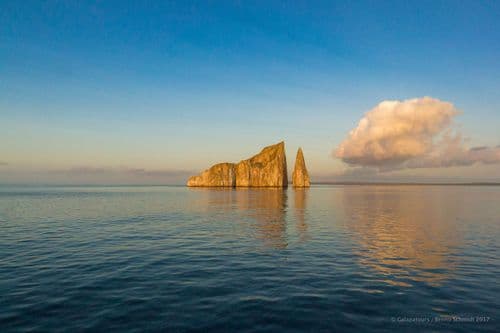



Info
Single Cabin Supplement
When booking online, you can choose the option to "Upgrade to single occupancy". This will guarantee you the whole cabin to yourself, for an additional fee. If you don't select this option, then another traveler of the same sex might be placed into the same cabin with you.
What's included
All meals onboard (International and Ecuadorian Cuisine). Almost all dietary requirements can be catered for with advance notice - please ask us about your needs.
Snorkeling sessions - whenever possible and allowed by the National Park.
Extensive Zodiac Rides to explore the shorelines and mangrove forests from close up.
All transport to and from the ship: Pick-up by your guide directly from the airport (if you arrive at the first day) and drop-off by your guide directly to the airport (if you leave on the last day).
English-speaking naturalist guides with you at all times during the excursions.
Briefings in the evening, during which your guide will explain what you can expect from your next day.
Lectures in the evenings about a variety of topics, including Geology, Marine Biology, Natural History, Human History, and more.
Entry costs to museums, research stations, breeding stations, etc.
Your booking contributes to our Conservation Project.
What's not included
Galápagos National Park Fee, payable in cash upon arrival at the airport in Galápagos (please see our FAQ)
INGALA Luggage Check Fee at the airport on the mainland: 20USD (please see our FAQ)
Alcoholic beverages onboard (please see our FAQ)
Bottled soft drinks onboard (Coke, Sprite etc.)
Tips & Gratuities for your Guide and Crew (please see our FAQ)
Travel Health Insurance
Reviews
FAQs
Are their any customs restrictions for travel to Galapagos?
Under Ecuadorian law, if you are only temporarily visiting the Galápagos then you are exempted from the requirement to pay any customs charges on items that you are bringing in to the country. This includes new or used portable electronics such as cameras, laptops, music players, etc.
You MUST NOT bring any agricultural or plant materials or any unprocessed food products to the islands. To avoid problems at customs and bag check we suggest only traveling to Galápagos with pre-wrapped snack products such as chocolate bars, etc. Food is plentiful and freshly cooked on your Galapatours cruise, with a wide range of choice on offer to suit all tastes - you really don't need to bring anything with you!
Do I need a visa to go to Galápagos?
As the Galapagos Islands are part of Ecuador, and all flights to the Galapagos depart from mainland Ecuador, you will need to enter Ecuador first.
Entering Ecuador: Every traveler is responsible for checking the individual visa requirements for their nationality. We recommend using https://www.passportindex.org/ to find out if you need a visa for Ecuador. At the time of writing, U.S. citizens do not need to apply for a visa beforehand. Similarly, visitors from the UK, Germany, and most other European countries do not require a visa for the Galapagos Islands. Upon entering the country, you will be given a visa stamp that permits you to stay in Ecuador for up to 90 days. This also applies to many other countries, but please verify the current visa regulations yourself before booking any tickets. In any case, your passport must be valid for at least six more months from the date of entry into Ecuador. You will also need to show proof of onward or return travel out of Ecuador to customs and immigration officials upon arrival; this can be a return or onward airline ticket. If you do not meet these requirements, you may not be allowed to enter the country.
Entering Galapagos: To enter Galápagos, the first official requirement is a valid Ecuadorian tourist visa stamp in your passport - this should have been issued to you upon arrival to mainland Ecuador.
What are the entry requirements for Galápagos?
This is a multi-layered question, that we have tried to answer in various articles. Please click on the corresponding links to learn more about the different topics. To recap:
- Passport & Visa: Tourists visiting the Galapagos Islands must have a valid passport and, in most cases, can obtain a visa upon arrival in Ecuador. Click here to read more.
- Luggage Check: When leaving Ecuador's main land, tourists' luggage will be checked for restricted items by the Tourist Control and Certification (TCC) to ensure the preservation of the islands' unique environment and wildlife. This check costs 20USD and is done at the airport in Quito or Guayaquil, before checking in for your flight to Galapagos.
- Entrance Fee: A Galapagos National Park entrance fee must be paid upon arriving in Galapagos.
- Travel Insurance: A travel insurance that covers emergency evacuation and medical expenses. is highly recommended, and even obligatory on board of some ships.
- Vaccinations: At the following link you can find out more about vaccinations for a Galápagos trip.
What is the Galápagos National Park Entrance Fee?
The Galápagos National Park Entrance fee is levied on all visitors to the islands. For foreign visitors, the entry fee is currently 100 USD per person (50 USD for children under 12 years old), but will be increased to 200 USD per person (100 USD for children) from 1 August 2024 onwards. If you are a citizen of a country in South America you might pay less, check here for more information.
Important: This fee must be paid, in cash, at the airport of arrival. If you do not pay, you will not be allowed to leave the terminal - so please make sure you have the means to pay the Galápagos entrance fee! Therefore, the payment of this entrance fee is indispensable to take part in a Galapagos cruise.
The entrance fees collected will be allocated to various local entities to support sustainability and community development in the Galápagos Islands. The proceeds are split between several important institutions as follows:
- 40% to the Galápagos National Park
- 20% to Galápagos Municipalities
- 10% to the National Institute
- 10% to Galápagos Province Local Government
- 5% to the National Navy
- 5% to the Ministry of Environment
- 5% to Quarantine and Pest Control
- 5% to the Galápagos Marine Reserve
For more information about the entrance fee structure and the distribution of funds, please visit the official website of the Galápagos National Park Administration.
What is the SICGAL baggage check?
To protect the vulnerable and unique Galapagos habitats and wildlife, no non-native plant or animal species must be allowed to arrive on the archipelago. SICGAL is the government department responsible for ensuring the islands are protected in this way.
After you have received your TCT/TCC card at the airport in Ecuador, you should proceed to the SICGAL booth. There you will be asked to fill out a form and may have your luggage examined.
To make sure you don't have any trouble here, please do not attempt to travel with any foods other than small quantities of pre-wrapped snack items like chocolate bars or similar, and certainly don't have any plants or plant materials in your bags. Once checked, you will receive an approval label to attach to your bags, and you can then make your way to your airline check in.
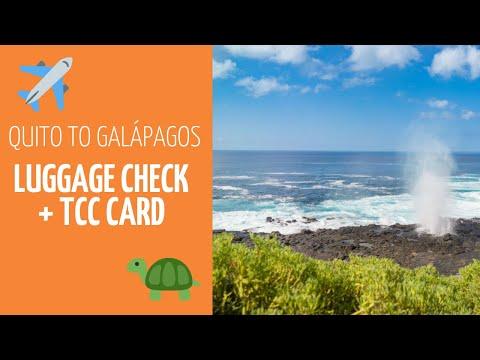
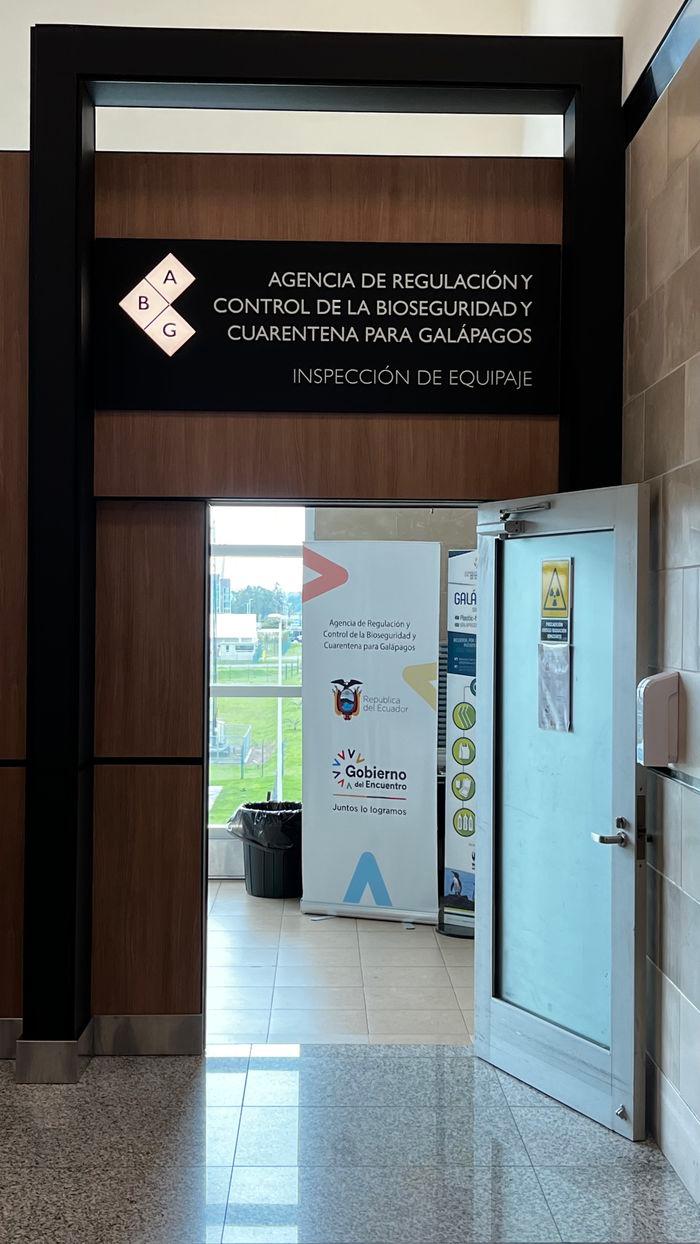
How long does it take to get to the Galápagos Islands?
Galapagos boasts two airports on Baltra and San Cristóbal Islands, offering daily flights from Quito and Guayaquil. Departing in the early morning, the journey from Quito to Galapagos takes approximately 2.5 hours, often including a brief stopover in Guayaquil. The direct flight from Guayaquil to Galapagos clocks in at around 1.5 hours. Three airlines currently serve Galapagos - Avianca, TAME and LATAM.
To mitigate any potential issues arising from flight delays or cancellations on your international leg, it is advisable to arrive in Quito or Guayaquil the night before your Galapagos departure. Ask us for advice on Ecuador hotels when you book your cruise with us.
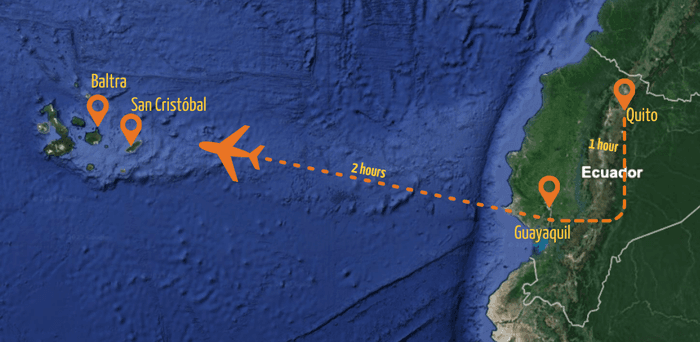
West, Central & East Galápagos
4.0
(7)
Price
Upon Request
